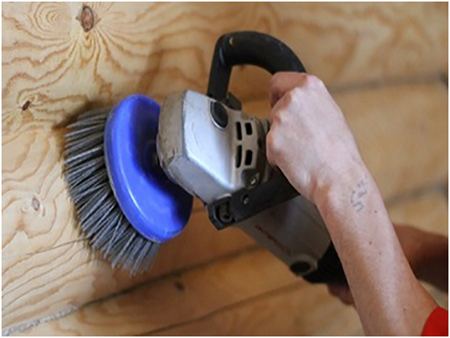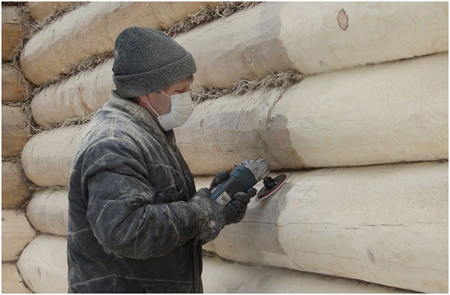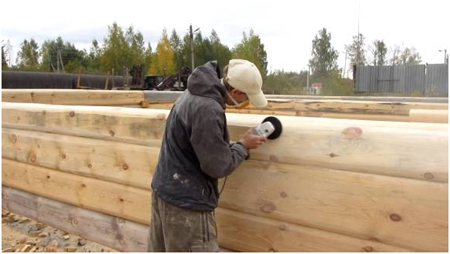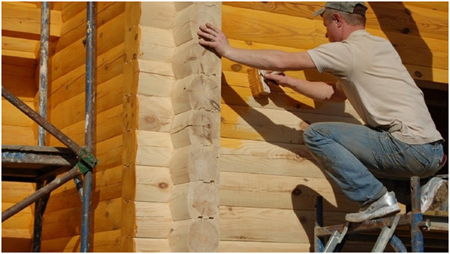The modern approach to wooden construction is the use of logs. The material has precise dimensions and a cleanly rounded shape, which allows the construction of a log house without a large amount of waste that appears in the process of fitting logs to each other. But regardless of this, it is necessary to carry out a number of works related to the protection of wood, where the polishing of rounded logs occupies a special place.
Log house sanding
The main purpose of sanding a log house is to give the wooden structure an attractive appearance and remove the top layer of wood that is infected with microorganisms. After the construction of a wooden house made of logs, it is not recommended to drive into it and live immediately. During the year, the house undergoes natural shrinkage, after which you can think about how and by what means to carry out the decoration.
More often, various protective impregnations are used for this, which not only protect the tree from the negative influence of microorganisms, but also emphasize the structure of the material. Therefore, the polishing of rounded logs must be approached responsibly, especially since this work is considered difficult.
Grinding rules
Like all construction processes, the polishing of a log house is divided into several stages.
Stage number 1 - preparatory
At this stage, you need to prepare the tools. The market today offers a fairly wide selection, where the belt type grinder comes first. But there is one point that inexperienced masters may not know about. If the house is built from a bar, that is, a material with flat edges, then a grinder is the best option. For processing logs with rounded edges, this tool is not suitable. In this case, it is better to use an angle grinder and special Osborne brushes.

Processing log walls with an angle grinder and Osborne brushes
Osborn brushes
The bristles of the brushes are made of nylon impregnated with silicon carbide. The material is wear-resistant, one tool is enough to clean 250-350 m². It is necessary to work with them at low speeds - up to 3500 rpm. It is not recommended to increase the speed. Reasons - the wood begins to burn and the ends of the pile melt.
For grinding logs or timber, different brands of brushes are used:
- P46 - rough cleaning and brushing.
- P60 - intermediate grinding.
- P80 - finishing.
- P120 - finishing.
The ease of use of Osborne brushes lies in the fact that with this tool you can get to hard-to-reach areas. In addition, we note the minimum amount of dust emitted during processing. Watch a video on how Osborne brushes are used when sanding a log house.
grinder with grinding discs
To carry out this type of work, the grinder is often used. The main thing is to choose the right power for it. An 850 watt instrument is perfect. Pay attention to the weight of the grinder, because grinding the log house is a lengthy process. A heavy unit will not allow you to use it for a long time (hands will “fall off”).
As for grinding wheels. The grinding process consists of four steps:
- Rough processing. Here you need a disk with large grains - No. 40.
- Fine-tuning. A tool number 80 or 100 is used. The task of the stage is to smooth out bumps and protruding pile.
- Fine grinding. Sandpaper number 150-180 is used.
- A finishing treatment that achieves perfect smoothness. Tool #220-240.
Please note that up to three discs are consumed per 1 m² of sanded surface, so you will have to stock up on a large number of them. When doing work with a grinder, it should be noted that this process is dusty. Therefore, it is necessary to take care of safety measures: glasses, gloves, a respirator.

Grinding a log cabin with a grinder
Sandblasting technology
This is an innovative way of processing log cabins from logs and timber, which differs from the two previous ones by the high quality of the work carried out. The technology is based on an abrasive mixture of different types of sand, which is applied to wooden surfaces under pressure.
The only negative is the availability of special sandblasting equipment, which costs a lot of money. The method requires the presence of a qualified foreman who has previously been trained.
Additional advantages of technology:
- The speed of the process. It is four times faster than working with a grinder or angle grinder.
- Uniform grinding of any sites, even hard-to-reach.
- There are no traces of abrasive on the wooden surface, which sometimes happens when using a grinder and grinding discs.
- In this way, infected areas and rotten ones are polished, bringing them to an ideal state.
- If the log house was painted or varnished from the inside, then the abrasive mixture easily removes the coating.

Abrasive-blast method of grinding a wooden house
Stage number 2 - the main
The process of polishing a log house requires patience from the manufacturer. There is a certain sequence that cannot be changed. Some useful tips from professionals:
- It is impossible to grind logs that have dried out badly. Wet wood is almost impossible to process. Its fibers are lifted up, the structure is lubricated. So there is no need to talk about a presentable appearance.
- The work is done from top to bottom.
- There will be a lot of dust when grinding logs with a grinder. Therefore, after finishing the grinding of the walls of the house, it is necessary to sweep with a broom or vacuum.
- Work is carried out before installing windows and doors, assembling the ceiling and floor. But the roof must be erected.
- The surfaces of the walls are divided into sections - grips. They are sanded one by one. This also applies to the external surfaces of the walls of the log house, and internal.
- Hard-to-reach places - the junction of logs in the corners of the building. Here the power tool will be useless. Therefore, the work will have to be done manually using a chisel. Better blade width - 20 mm. Actively go deep in hard-to-reach places is not worth it. A small removed layer is the optimal solution.
- Before using a newly installed disc, it is recommended to grind it a little to remove large protruding grains. Turning is best done at the ends of the logs, which form openings in the wall. Subsequently, they are closed with boxes of windows or doors, so that this will not affect the appearance of the log house.
- It is recommended to move the grinder not with the hands, but with the shoulder girdle. This will create a smooth movement of the tool, due to which differences in the plane will not form on the surface of the sanded logs. Plus - such work will not let a person get tired quickly.
The sequence of work carried out is as follows. First, the main planes of the logs are ground, then the ends, and lastly the grooves. With the processing of grooves you need to be careful. The grinder disc can get stuck in them, and this can lead to pulling the power tool out of your hands. So attention and only attention. In this regard, the Osborne grinder and brushes are safer, not to mention sandblasting technology.

Grinding grooves between wooden building elements
Treatment of the log house with protective compounds
Wood is a soft and fibrous material. Humidity and microorganisms in a few years turn it into an unusable material, therefore, after grinding logs and beams, their surfaces must be covered with antiseptic and flame retardant compounds. The former are responsible for the safety of lumber from the negative effects of mold and fungi, the latter increase fire resistance.
Protective liquids are applied with conventional painting tools: brushes and rollers. If the treatment area is large, then a spray gun is used. First of all, an antiseptic is applied, after it has dried and absorbed into the wood, a fire retardant is applied.
There is another composition that gives the tree certain shades. It is called glazing material. There are more than 40 varieties of glazing compounds on the market today, which give wooden walls different shades, there are also colorless options among them.
It should be noted that protective liquid materials are divided into two categories: for indoor use and outdoor. They cannot be interchanged, because for external use the compounds are very toxic, although they have higher protective properties.

Covering the log house with an antiseptic using a maklovitsa
Conclusion
Grinding the wooden walls of a log house built from logs or beams is a mandatory procedure that gives the building a presentable appearance. In this case, a small layer of wood is removed, often infected with harmful microorganisms and rot. That is, the walls of a wooden house are “healed”, due to which the service life of the entire structure is increased.